Building Envelopes & Wraps
Bid Goodbye to the ‘Ostrich Syndrome’
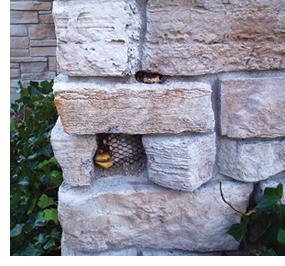 |
In the construction industry, many premature failures are a result of shortcuts taken to circumvent good standard practices. The reasons or excuses for taking these shortcuts are that they save time, they save material and, therefore, they save money! The term “value engineering” sounds professional, but in many cases, it is short-term gain with long-term negative consequences. If it is truly the same quality and quantity for less money, that is value gained. If it is just less quantity and quality for less money, there is no value gained, value actually is lost.
When construction professionals and others involved with a building project make a decision to take shortcuts on materials, quality and labor, the construction details involved don’t last as long and, often, end in catastrophic failure.
When it comes to value-engineering moisture management components, details and systems, you had better know what you are doing. Sometimes there are good reasons for choosing a less-expensive system; sometimes the owner’s budget just can’t afford the better, more expensive system. If the system is of the type that can be upgraded in the future, when funds are available to do so, or if its service life can be extended with a good maintenance plan that allows for a pay-as-you-go solution, then choosing the less-expensive system makes sense/cents.
However, if it is the type of moisture management system that is incorporated into the exterior building envelope and not accessible at a later date for an upgrade or for maintenance, then the decision-making process needs to be different.
The irony is that it is just this type of moisture management system that gets downgraded during some of the value engineering efforts. Not being accessible can mean it is buried (covered up) in a wall or roof system, or it can mean it is just hard to access or out-of-sight like in a high roof system.
In any case, these are not the parts of an exterior building envelope to cheapen up or cut corners. When moisture management systems fail prematurely, there are few building materials in close proximity to this type of failure that will do well. Water is the universal solvent. Given time, all things succumb to water. And, while it is happening, they look bad and, in some cases, smell bad. They can also be hazardous to health and safety.
Another factor that needs to be considered when choosing a moisture management system is: If it was to fail or if it was in the process of failing, when will it show? The real problem with some moisture management systems is that they can be in a failure mode for a long time, sometimes even for years, before the failure becomes outwardly apparent.
In many cases, the complete structure is in failure mode by the time it shows up as a cosmetic surface blemish. This has been the case with some major failures of the two-coat stucco systems. The building owners started to notice discoloration on interior sheetrock or plaster, or discoloration on exterior veneers. When the walls were opened up, the damage was so extensive, the building could not be saved. They were condemned and demolished.
The news reports have focused on stucco systems, but these types of catastrophic failure can and do occur in other veneer systems such as thin and full stone, thin and full brick and many other siding systems.
Case and point
A real-life example of this occurred in a home on Lake Michigan. A homeowner was doing some yard work around his 4 year-old, $4 million, full stone veneer house, when he happened to notice a toad stool mushroom protruding from the surface of the stone around the chimney. When the wall was opened, the exterior building envelope forensic experts concluded the home was beyond repair.
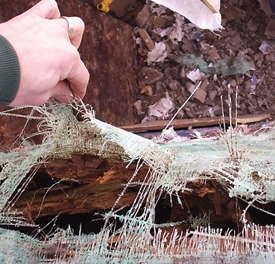 |
|
Unfortunately, this scenario is all too common. The surface blemish, either on the interior or exterior, that initially looks like a minor problem is, in reality, a moisture management failure that has been in progress for a long period. And what looked like a cosmetic surface issue is really an extensive and expensive structural failure problem. An expensive home, with a high-quality full stone veneer, is jeopardized by a low-cost or non-existent exterior building envelope moisture management system. (See A.)
The terms “material compatibility” and “holistic building” are not just hot-button topics. The selection of compatible building materials is critically important in sustainable building. The structural failure in the building envelope of the $4 million Lake Michigan home was the result of incompatible building materials and a lack of holistic design and planning. A full stone veneer rainscreen is not a barrier system; therefore, the moisture that egressed through the full stone veneer was trapped behind the stone veneer and at the face of the weather resistant barrier (WRB). The moisture was trapped there for extended periods, allowing some of it to be absorbed into and through the WRB.
Some of this moisture continued moving inward, into and through the sheathing, reaching as far as the rim joists and rim joist plates. This trapped moisture spread like a cancer through the building envelope, resulting in such devastation that the demolition contractor was able to scoop out ruined sheathing, studs and rim joists with his bare hands!
As bad as this sounds, it is not an uncommon entrapped moisture scenario. The IBC, Section 1403.2 “Weather Protection” states that there must be a method to drain water from the wall assembly. The IRC, Section 703.1.1 “Water Resistance” states that the wall assembly (building envelope) must include a method to drain any accumulated water.
In other words, if the rainscreen of the exterior building envelope is not a barrier system, the design of the exterior building envelope must provide a passageway for moisture that enters the system to efficiently drain back out of the system. An effective drainage plane system with a good weep system is needed. (See B.)
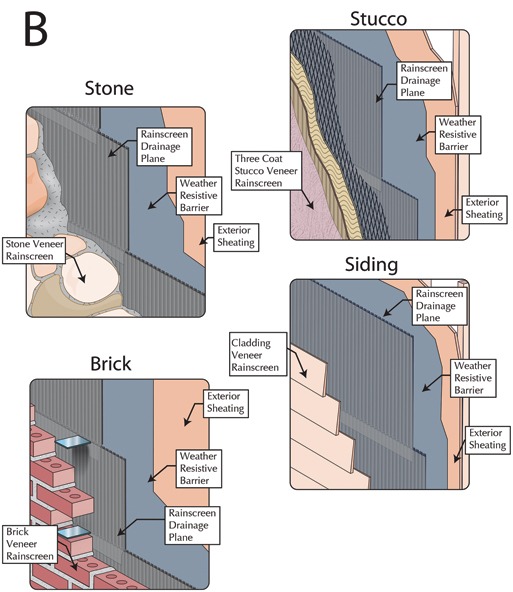
It is an unfortunate reality that the construction industry seems to need to be sued into compliance. The masonry industry receives many calls each year from legal firms inquiring about the availability of rainscreen drainage plane technology to the construction industry. The logical conclusion that can be reached from these inquiries is that someone is about to be sued for failing to include a rainscreen drainage system in the exterior building envelope, resulting in structural failure from entrapped moisture. Construction professionals can, under limited circumstance, plead ignorance, but at a certain point, they will be held accountable.
During the last 30 to 40 years, the construction industry has experienced increased entrapped moisture problems in the exterior building envelope. These recurring moisture management problems have increased for a number of reasons: a less-skilled labor force, many new materials that often went unchecked for compatibility with other materials, deviations from standard construction practices (and, in some cases, from code), and the lack of coordination between all parties involved in the construction project.
The good news is that there are now ways to solve these issues both for financial gain and for the betterment of the construction industry, and a well-designed rainscreen drainage system is at the top of that list.
Rainscreen drainage planes that are properly designed and installed, in conjunction with the appropriate weep system and other required detail components, greatly diminish the risk of entrapped moisture in the exterior building envelope. (See C.)
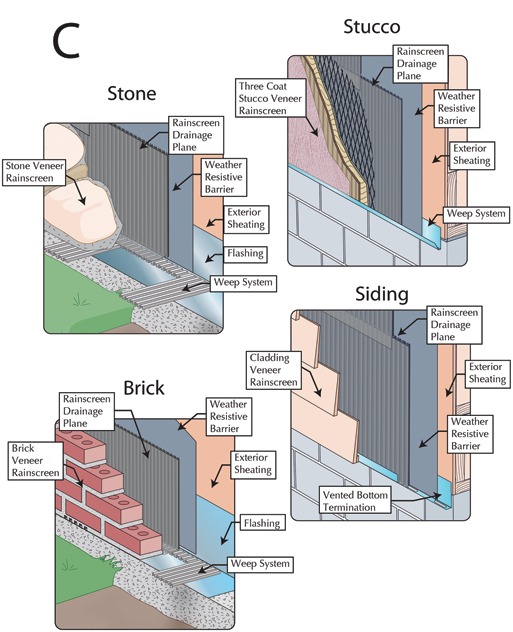
The rainscreen veneer of an exterior building envelope is the most exterior surface of a building envelope. It is the first surface that attempts to change the exterior ambient conditions to the desired interior ambient conditions. In many cases, they are not barrier systems and are not designed to be barrier systems (see IBC, Section 1403.2 “Weather Protection” and IRC, Section 703.1.1 “Water Resistance”), and they do take on moisture.
In most scenarios, they do a number of things:
- They protect other exterior building envelope components from UV damage
- They absorb and resist the kinetic energy of wind and wind-driven materials (snow, rain, hail)
- They provide aesthetic appeal
- They facilitate maintenance
- They enhance durability (however, in most cases, they are not structural).
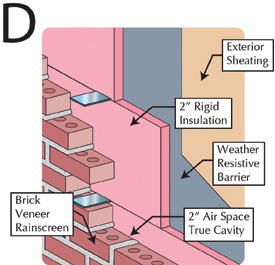 |
|
Common rainscreen veneers include stone, bricks, stucco, man-made thin-stone, man-made thin-bricks, thin stone, cladding and more. The layer immediately behind these rainscreen veneer materials should be a void or plane that separates the backside of the rainscreen from the other exterior building envelope components. In rainscreen walls with full brick or full stone veneers, this void/plane is commonly called a cavity. These cavities vary in width from a code compliant one inch to larger cavities of two to four inches. Some designs include rigid insulation installed in part of the cavity. For example, the cavity will start off as a four-inch void, and then two inches of rigid insulation is installed in the cavity, leaving a two-inch air space. The two-inch air space in this example is the cavity (see D).
For years, stucco and other thin veneers (thin stone, thin bricks, etc.) relied heavily on the use of lath to create a separation/void. In many cases, this system consisted of one- X two-inch strips of wood nailed vertically onto the exterior sheathing and over the WRB. They were aligned with the studs (see E). This was an expensive solution, because it was so labor intensive. Its functionality also was closely tied to the labor force installing it.
The other most common rainscreen drainage detail involved two layers of WRB material. Originally, this detail consisted of one- X 12-inch wood boards, laid horizontally over wood studs with little or no insulation. Two layers of asphalt-impregnated construction paper were placed on top of the wood backup wall. Next, expanded metal lath was fastened on top of the two layers of construction paper. The final layer consisted of three-coat stucco (see F).
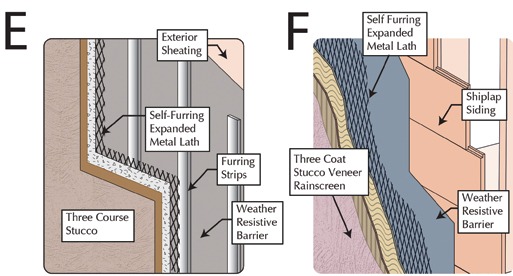
The theory behind the two layers of construction paper was when moisture penetrated the stucco veneer and migrated into the construction paper, the top layer would wrinkle, creating a drainage space or void for the moisture to travel downward and out of the building envelope. The drainage/drying capabilities of this configuration were generally satisfactory.
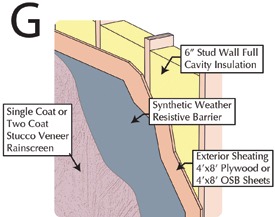 |
|
As time progressed, the sheathing changed to four- X eight-foot sheets of plywood and, eventually, to four- X eight-foot sheets of OSB. The WRBs changed to various types of synthetics, and the studs changed to a two X six inches, with a great deal of insulation (see G).
Even the stucco changed, with one or two coats becoming the norm. Less material means less protection from moisture intrusion into the building envelope. The drainage/drying capabilities of this new configuration were generally less than satisfactory.
The rush to increase profits (or in some cases, just to maintain profits and stay competitive) had short-term gains, but long-term liabilities. There were lots of lawsuits, because these systems failed. The products and systems also incurred a negative image in the construction industry. Customers suffered and so did the building industry.
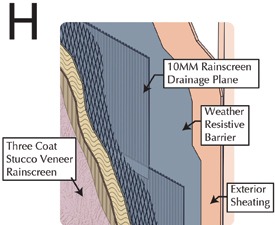 |
|
In Canada, these failures led to new codes that established requirements for rainscreen drainage planes (2005 National Building Code of Canada, Subsection 9.27.2.2(b), Minimum Protection from Precipitation Ingress) (see H).
In April 2010, Oregon began enforcing a code required rainscreen drainage plane (or gap) of at least 1/8 inch (Oregon Residential Specialty Code 2008 sections R703.1 and R703.2). Many other states have pledged to enact building codes requiring rainscreen drainage, and some U.S. municipalities have interpreted existing code to mean that building envelopes that don’t contain a barrier system must include rainscreen drainage.
Many large U.S. homebuilders and apartment builders also have begun to include rainscreen drainage in their projects. Unfortunately, this movement has been spurred on by extensive warranty claims and insurance losses. They are beginning to realize that the risk of entrapped moisture leading to structural failure far outweighs the cost of prevention secured by including a well-designed and installed rainscreen moisture management system (rainscreen drainage plane/mat, weeps and appropriate accessories).
Conclusion
A wealth of evidence points to the necessity of rainscreen building envelope moisture management systems. Records of structural failure and the resulting lawsuits and awards are easily found, and the number of countries, states and municipalities demanding their inclusion continues to grow. Any professional in the construction industry who continues to ignore this importance does so at his own peril.
Be proactive and include a well-designed, ICC and CCMC-R evaluated rainscreen drainage plane – with the appropriate weep system and accessories – in your next project, and say “goodbye” to the Ostrich Syndrome forever.
| Product Watch |
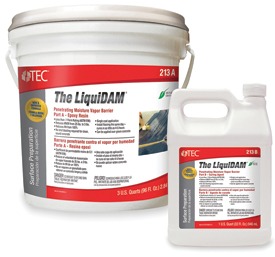 TEC’s The LiquiDAM Penetrating Moisture Vapor Barrier delivers less than .1 permeability of water vapor through the membrane.Moisture penetration through concrete slabs can cause severe problems for flooring systems. Even relatively low moisture emissions (MVER) can lead to the deterioration of flooring adhesives. The new and improved formula delivers a higher level of moisture protection than the current version, while keeping the same time- and labor-saving benefits. TEC’s The LiquiDAM Penetrating Moisture Vapor Barrier delivers less than .1 permeability of water vapor through the membrane.Moisture penetration through concrete slabs can cause severe problems for flooring systems. Even relatively low moisture emissions (MVER) can lead to the deterioration of flooring adhesives. The new and improved formula delivers a higher level of moisture protection than the current version, while keeping the same time- and labor-saving benefits.
The formula continues to require no shot blasting for clean, sound concrete and allows same-day flooring installation with a one-coat, fast-drying formula that cures in four to five hours and exceeds the newly released ASTM F3010-13 standard for moisture vapor barriers. When used as a complete TEC system with other surface preparation products and flooring adhesives, The LiquiDAM also qualifies for a 20-year Moisture Control Limited System Warranty. The LiquiDAM Penetrating Moisture Vapor Barrier can be applied to new or existing concrete with a maximum relative humidity of 100 percent and a moisture vapor emission rate of 25 pounds per 1000 square feet, per 24 hours. Applied with a squeegee or a 1/16-inch-square notch trowel and a 3/16-inch nap foam roller, one coat boasts more than 150 square feet of coverage, depending on surface porosity. For more information, visit tecspecialty.com. |
| Case Study |
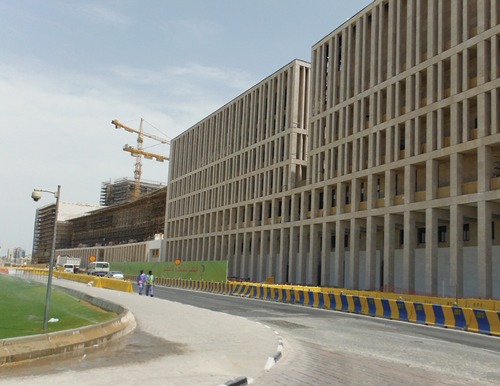 At the $5.5 billion Downtown Doha development in Qatar, Grace Construction Products’ Preprufe waterproofing membrane has been specified to provide a waterproofing solution. At the $5.5 billion Downtown Doha development in Qatar, Grace Construction Products’ Preprufe waterproofing membrane has been specified to provide a waterproofing solution.
Downtown Doha is said to be “the world’s first sustainable downtown regeneration project,” was and designed and built by Msheireb Properties, the country’s leading sustainable developer. The 76-acre development aims to blend traditional Qatari heritage with modern, sustainable technologies. Preprufe offered a waterproofing system that combines watertightness, low environmental impact and long-term performance with a fast, simple application in temperatures regularly topping 40 degrees Celsius. Starting on site in 2010, about 300,000m2 of Preprufe 300R waterproofing membrane has been applied to prevent water penetration and migration around the development’s extensive substructures. With the final phases of construction set to commence in 2013, Grace will complete the application of more than 600,000m2 of Preprufe 300R to keep the landmark project watertight and on course for its 2016 completion date. Designed with synthetic adhesive layers combined with a robust HDPE film, Preprufe provides a permanent physical barrier that will protect each structure against chloride and sulphate attack. Grace’s patented Advanced Bond Technology enables concrete to aggressively adhere to Preprufe, forming a unique intimate seal to prevent any water migration between the waterproofing and the structure, substantially reducing the risk of leaks. The Preprufe system protects a substructure from the harmful effects of water, vapor and gas. It can be applied on wet substrates and is immediately trafficable after installation without protective layers, which makes for fast and easy application. When compared to traditional loose-laid PVC systems, Preprufe is more than five times quicker – with about 500m2 laid in one day, compared to 60 to 100m2 of PVC during the same time period. To complete the comprehensive application, Grace supplied 100,000m2 of Bituthene 8000 HC waterproofing membrane to deliver complete structural protection against the water table and aggressive ground conditions. When complete, the project will comprise more than 100 residential and commercial properties that reflect the culture and aspirations of the people of Qatar. Designed to generate less waste, deliver long-term cost savings and minimize its own carbon footprint, Msheireb Downtown Doha will become an iconic landmark in Qatar – while benefitting from the performance of the Preprufe waterproofing solution from Grace. For more information, visit www.preprufe.com. |